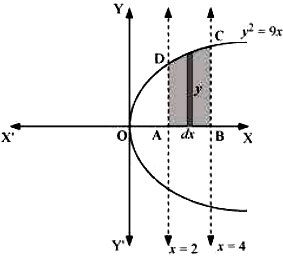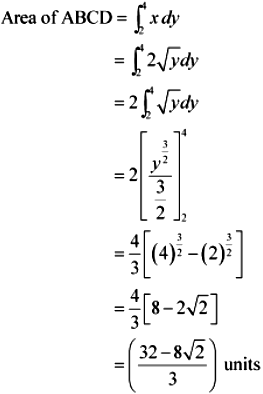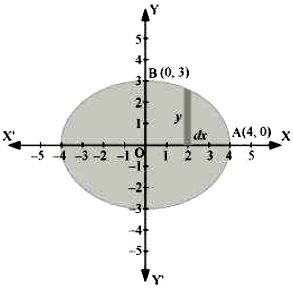NCERT Solutions Class 12 Maths Chapter 8 Applications of Integrals
1. Find the area of the region bounded by the curve y2 = x and the lines x = 1, x = 4 and the x-axis.
Answer:

The area of the region bounded by the curve, y2 = x, the lines, x = 1 and x = 4, and the x-axis is the area ABCD.

2. Find the area of the region bounded by y2 = 9x, x = 2, x = 4 and the x-axis in the first quadrant.
Answer:

The area of the region bounded by the curve, y2 = 9x, x = 2, and x = 4, and the x-axis is the area ABCD.

3. Find the area of the region bounded by x2 = 4y, y = 2, y = 4 and the y-axis in the first quadrant.
Answer:

The area of the region bounded by the curve, x2 = 4y, y = 2, and y = 4, and the y-axis is the area ABCD.

4. Find the area of the region bounded by the ellipse \(\frac{x^2}{16} + \frac{y^2}{9} = 1\)
Answer:
The given equation of the ellipse, \(\frac{x^2}{16} + \frac{y^2}{9} = 1\), can be represented as

It can be observed that the ellipse is symmetrical about x-axis and y-axis.
∴ Area bounded by ellipse = 4 × Area of OAB

Therefore, area bounded by the ellipse = 4 × 3π = 12π units
5. Find the area of the region bounded by the ellipse \(\frac{x^2}{4} + \frac{y^2}{9} = 1\)
Answer:
The given equation of the ellipse can be represented as


It can be observed that the ellipse is symmetrical about x-axis and y-axis.
∴ Area bounded by ellipse = 4 × Area OAB

Therefore, area bounded by the ellipse = \(4 \times \frac{3\pi}2\) = 6π units .
6. Find the area of the region in the first quadrant enclosed by x-axis, line x = √3y and the circle x2 + y2 = 4.
Answer:
The area of the region bounded by the circle, x2 + y2 = 4, x = √3y, and the x-axis is the area OAB.

The point of intersection of the line and the circle in the first quadrant is (√3, 1).
Area OAB = Area ∆OCA + Area ACB

Therefore, area enclosed by x-axis, the line x = √3y, and the circle x2 + y2 = 4 in the first quadrant = \(\frac{\sqrt3}2 + \frac\pi3 - \frac{\sqrt3}{2} = \frac\pi3\) units.
7. Find the area of the smaller part of the circle x2 + y2 = a2 cut off by the line \(x = \frac a {\sqrt2}\).
Answer:
The area of the smaller part of the circle, x2 + y2 = a2, cut off by the line, \(x = \frac a {\sqrt2}\), is the area ABCDA.

It can be observed that the area ABCD is symmetrical about x-axis.
∴ Area ABCD = 2 × Area ABC

Therefore, the area of smaller part of the circle, x2 + y2 = a2, cut off by the line, \(x = \frac a {\sqrt2}\), is \(\frac{a^2}2 \left(\frac\pi2 - 1\right)\) units.
8. The area between x = y2 and x = 4 is divided into two equal parts by the line x = a, find the value of a.
Answer:
The line, x = a, divides the area bounded by the parabola and x = 4 into two equal parts.
∴ Area OAD = Area ABCD

It can be observed that the given area is symmetrical about x-axis.
⇒ Area OED = Area EFCD

From (1) and (2), we obtain

Therefore, the value of a is \((4)^\frac23\).
9. Find the area of the region bounded by the parabola y = x2 and y = |x|
Answer:
The area bounded by the parabola, x2 = y, and the line, y = |x|, can be represented as

The given area is symmetrical about y-axis.
∴ Area OACO = Area ODBO
The point of intersection of parabola, x2 = y, and line, y = x, is A (1, 1).
Area of OACO = Area ∆OAB – Area OBACO

⇒ Area of OACO = Area of ∆OAB – Area of OBACO
\(= \frac12 - \frac13\)
\(= \frac16\)
Therefore, required area = \(2\left[\frac16\right] = \frac13\) units.
10. Find the area bounded by the curve x2 = 4y and the line x = 4y – 2.
Answer:
The area bounded by the curve, x2 = 4y, and line, x = 4y – 2, is represented by the shaded area OBAO.

Let A and B be the points of intersection of the line and parabola.
Coordinates of point A are \(\left(-1, \frac14\right)\).
Coordinates of point B are (2, 1).
We draw AL and BM perpendicular to x-axis.
It can be observed that,
Area OBAO = Area OBCO + Area OACO …(1)
Then, Area OBCO = Area OMBC – Area OMBO

Similarly, Area OACO = Area OLAC – Area OLAO

Therefore, required area = \(\left(\frac56 + \frac7{24}\right) = \frac98\) units.